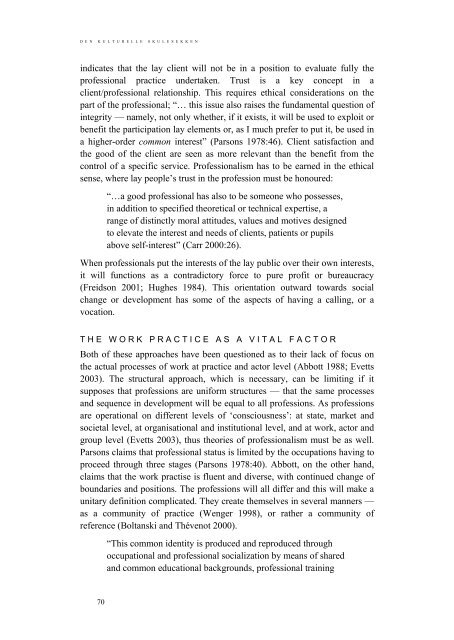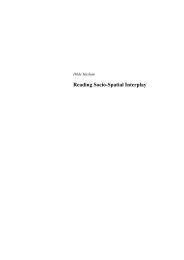CON ⢠TEXT - Arkitektur- og designhøgskolen i Oslo - AHO
CON ⢠TEXT - Arkitektur- og designhøgskolen i Oslo - AHO
CON ⢠TEXT - Arkitektur- og designhøgskolen i Oslo - AHO
- No tags were found...
You also want an ePaper? Increase the reach of your titles
YUMPU automatically turns print PDFs into web optimized ePapers that Google loves.
D E N K U L T U R E L L E S K U L E S E K K E Nindicates that the lay client will not be in a position to evaluate fully theprofessional practice undertaken. Trust is a key concept in aclient/professional relationship. This requires ethical considerations on thepart of the professional; “… this issue also raises the fundamental question ofintegrity — namely, not only whether, if it exists, it will be used to exploit orbenefit the participation lay elements or, as I much prefer to put it, be used ina higher-order common interest” (Parsons 1978:46). Client satisfaction andthe good of the client are seen as more relevant than the benefit from thecontrol of a specific service. Professionalism has to be earned in the ethicalsense, where lay people’s trust in the profession must be honoured:“…a good professional has also to be someone who possesses,in addition to specified theoretical or technical expertise, arange of distinctly moral attitudes, values and motives designedto elevate the interest and needs of clients, patients or pupilsabove self-interest” (Carr 2000:26).When professionals put the interests of the lay public over their own interests,it will functions as a contradictory force to pure profit or bureaucracy(Freidson 2001; Hughes 1984). This orientation outward towards socialchange or development has some of the aspects of having a calling, or avocation.THE WORK PRACTICE AS A VITAL FACTORBoth of these approaches have been questioned as to their lack of focus onthe actual processes of work at practice and actor level (Abbott 1988; Evetts2003). The structural approach, which is necessary, can be limiting if itsupposes that professions are uniform structures — that the same processesand sequence in development will be equal to all professions. As professionsare operational on different levels of ‘consciousness’: at state, market andsocietal level, at organisational and institutional level, and at work, actor andgroup level (Evetts 2003), thus theories of professionalism must be as well.Parsons claims that professional status is limited by the occupations having toproceed through three stages (Parsons 1978:40). Abbott, on the other hand,claims that the work practise is fluent and diverse, with continued change ofboundaries and positions. The professions will all differ and this will make aunitary definition complicated. They create themselves in several manners —as a community of practice (Wenger 1998), or rather a community ofreference (Boltanski and Thévenot 2000).“This common identity is produced and reproduced throughoccupational and professional socialization by means of sharedand common educational backgrounds, professional training70
















